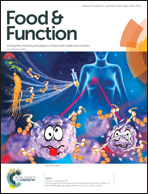
“Three new stilbenoids (1-3) and 16 known stilbenoids (4-6) and cannabinoids (7-19) were isolated from the leaves of hemp (Cannabis sativa L.). The structures of the three new compounds were identified as α,α’-dihydro-3′,4,5′-trihydroxy-4′-methoxy-3-isopentenylstilbene (HM1), α,α’-dihydro-3,4′,5-trihydroxy-4-methoxy-2,6-diisopentenylstilbene (HM2), and α,α’-dihydro-3′,4,5′-trihydroxy-4′-methoxy-2′,3-diisopentenylstilbene (HM3) by 1D and 2D NMR spectroscopy, LC-MS, and HRESIMS. The known α,α’-dihydro-3,4′,5-trihydroxy-4,5′-diisopentenylstilbene (5) and combretastatin B-2 (6) were isolated for the first time from C. sativa f. sativa.
These isolated compounds exhibited cytotoxic effects on human cancer cells via inhibiting the proliferation of cancer cells and inducing cell death. Among them, compounds 4, 5, 10, 12, 13, 15, and 19 displayed broad-spectrum cytotoxicity, and 1, 7, and 11 displayed selectivity in inhibition efficiency on MCF-7 and A549 cells, which suppressed the proliferation of cancer cells significantly by inducing cell death.
The effects of compounds 1-3 on improving reverse cholesterol transport (RCT) were evaluated by isotope-tracing and western blotting. Results showed that the three stilbenoids showed a cytotoxicity above 1.0 mg L-1, especially that of HM3. They could improve [3H]-cholesterol efflux from Raw 264.7 macrophages to high density lipoproteins by enhancing the protein expression of ABCG1 and SR-B1, and HM1 and HM2 showed a significant difference compared with fenofibrate at 1.0 mg L-1. The three stilbenoids could also significantly improve the protein expression of ABCA1. Further study on HepG2 cells indicated that they improve the protein expression of LDLR, SR-B1 and CYP7A1, especially that of HM1 and HM3. However, they showed no significant effect on PCSK9.
The above results indicated that these stilbenoids may elevate the transfer of cholesterol to hepatocytes by improving the protein expression of SR-B1 and LDLR, and the synthesis of bile acid by increasing the protein expression of CYP7A1.
In conclusion, HM1 showed lower cytotoxicity and higher activity in improving the RCT-related protein expression. Our study suggests that it may be explored as a novel lipid-lowering drug and as a beneficial ingredient in health functional foods and pharmaceuticals.”
https://www.ncbi.nlm.nih.gov/pubmed/30500001
https://pubs.rsc.org/en/Content/ArticleLanding/2018/FO/C8FO01896K#!divAbstract









 “Cannabis is one of the most widely used plant drugs in the world today. In spite of the large number of scientific reports on medical marijuana there still exists much controversy surrounding its use and the potential for abuse due to the undesirable psychotropic effects. However, recent developments in medicinal chemistry of novel non-psychoactive synthetic
“Cannabis is one of the most widely used plant drugs in the world today. In spite of the large number of scientific reports on medical marijuana there still exists much controversy surrounding its use and the potential for abuse due to the undesirable psychotropic effects. However, recent developments in medicinal chemistry of novel non-psychoactive synthetic 